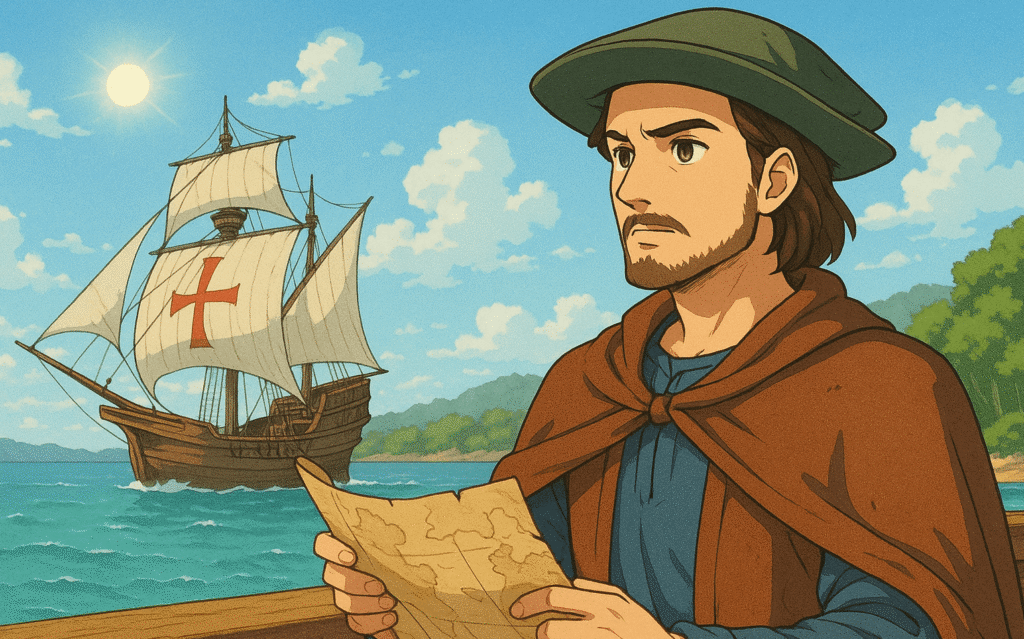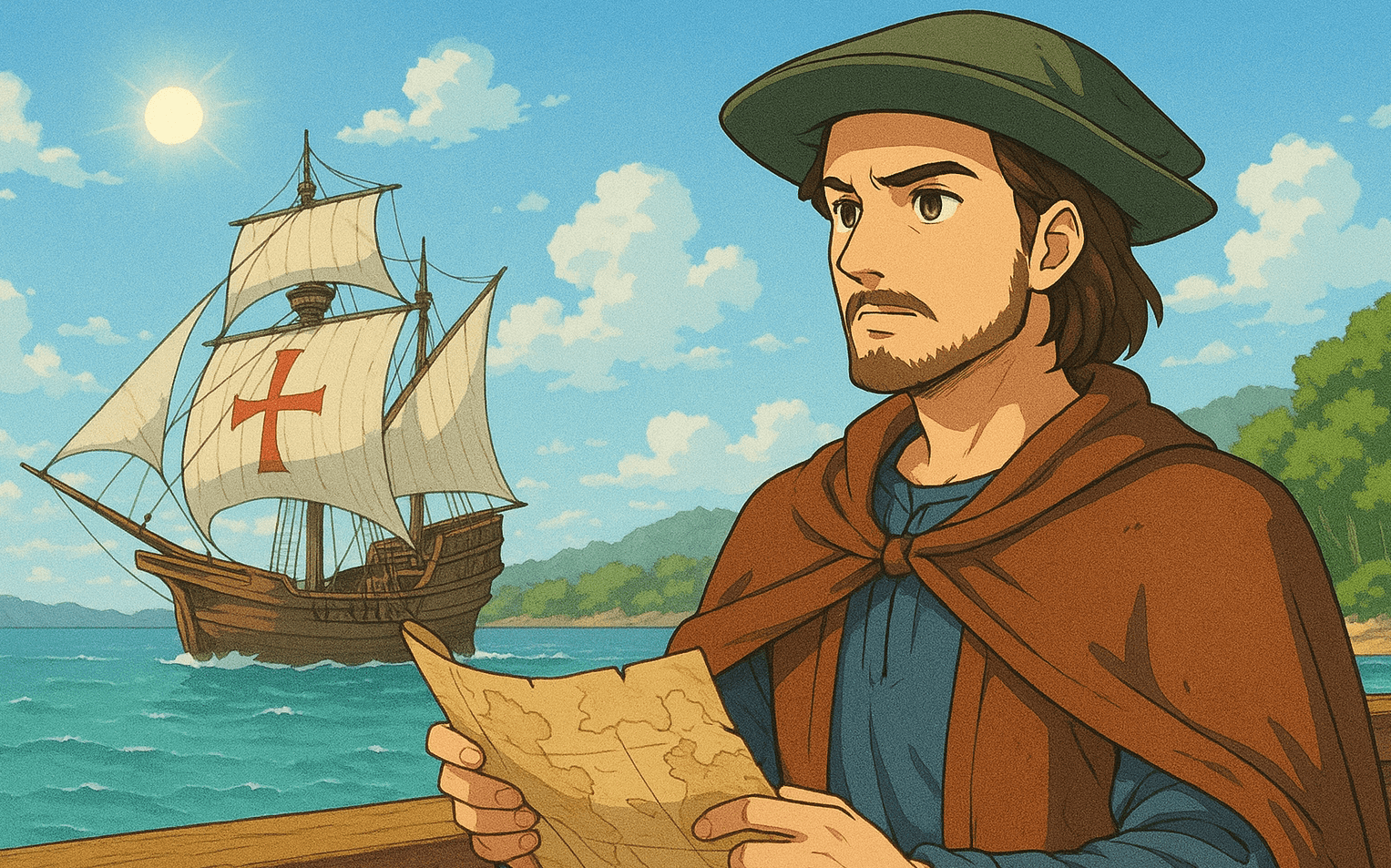Exploration and Colonization (1400–1800) – Trade, Power, and Global Impact

Launch of Ocean‑Going Ventures
European merchants spent much of the fourteenth century hunting for reliable spice pipelines after Ottoman tolls squeezed caravans through the eastern Mediterranean. Aromatics such as pepper and cloves carried margins so high that a single cargo could fund several fleets. To protect that prize, coastal engineers in Portugal and the Crown of Castile financed nautical trials along Africa and the Atlantic islands.
Three inventions formed the technical backbone of these trials. First, the caravel combined a strong hull with a lateen sail that caught headwinds at oblique angles, letting pilots tack rather than drift. Second, the magnetic compass gave mariners a fixed bearing even under heavy cloud, shrinking the risk of running blind. Third, an improved astrolabe delivered latitude data within one degree. Tables compiled by Jewish astronomer Abraham Zacuto circulated among pilots, turning star watching into spreadsheet‑like navigation.
Supply lines followed each landmark. Sugar plantations on Madeira and the Azores proved that island soil and forced labor could pump out sweetener for northern taverns. The economic template—monoculture fields, fortified ports, enslaved Africans shipped by boat—would soon leap across the Atlantic.
Meanwhile, the Treaty of Tordesillas in 1494 drew an invisible meridian roughly 370 leagues west of Cape Verde. Lands east fell under Portuguese influence; lands west under Castilian influence. Though drafted in Latin, the line functioned as the first multilateral clause about overseas claims: a lesson that paperwork tries to tame geography but often bends once boots hit sand.
Atlantic Crossings and Indian Ocean Gateways
Iberian Momentum
In 1488 Bartolomeu Dias rounded the southern tip of Africa, naming it the Cape of Good Hope because it opened a sea lane toward Asia. Vasco da Gama capitalized on that intelligence a decade later, reaching Calicut on the Malabar Coast. Local brokers sized up European cargo—woolen cloth, honey, tin—and found most of it unappealing. They wanted silver. The Portugueses returned with bullion and cannon‑armed caravels, securing trading factory rights at Goa and Malacca. Unlike previous medieval caravans that rented storage at inland fairs, these ocean merchants built stone warehouses and artillery towers right on the shoreline, merging logistics and defense in one site.
Castilian Westward Strategy
Castile opted for a westward gamble. Supported by maps that underestimated Earth’s girth, Cristoforo Colombo sailed in 1492 and recorded landfall on islands now in the Bahamas. He assumed he had skirted Asia. Only later did Italian navigator Amerigo Vespucci explain that the coast south of the Caribbean formed a separate continent. Mapmaker Martin Waldseemüller labeled it America in Vespucci’s honor, an early branding decision that stuck.
The crown moved fast. Governorships called adelantados combined judicial, fiscal, and military authority under one title. Conquistadors such as Hernán Cortés and Francisco Pizarro toppled Mexica and Inca polities by allying with local rivals, introducing steel blades, gunpowder bursts, and horses into battles formerly fought with slings and obsidian. Smallpox rode along, shredding demographic resistance faster than any siege engine. Silver from Potosí and Zacatecas then flooded Seville’s Casa de Contratación, swelling European coin counts and sparking the sixteenth‑century price surge economists still label the Price Revolution.
First Global Loop
Ferdinand Magellan, backed now by Habsburg Spain, crossed the Strait later bearing his name in 1520 and reached the Philippines. Though Magellan died during island skirmishes, surviving sailors continued west to Seville in 1522, proving a ship could encircle the planet. Insurance underwriters took notes: route feasibility lowers premium settings far more than wind lore. A Manila galleon link later carried American silver to Asian ports, where merchants exchanged it for silk, porcelain, and spices, turning the Pacific into a bullion highway.
Northern Rivals and Corporate Colonies
Dutch and English Charter Companies
By the early seventeenth century, Amsterdam ledger keepers built a new tool: the joint‑stock company. Shares in the Vereenigde Oostindische Compagnie (VOC) spread voyage risk across thousands of investors, letting directors dispatch convoys of armed Indiamen through the Cape to Batavia without imperiling single fortunes. The English Crown copied the format in 1600 by granting a royal charter to the East India Company (EIC). Both entities signed treaties, coined money, fielded soldiers, and negotiated with Mughal or Javanese courts, showing that a private board could wield public‑style influence.
Clove monopolies in the Moluccas, nutmeg from Banda, and tea from Fujian all passed through Batavia or Calcutta, then to European auction rooms ringing with the cry of commodity brokers. Futures contracts allowed traders to lock in cargo prices before the fleet even cleared the Sunda Strait. The tactic hedged volatility in a manner that modern commodity desks still admire, minus the wooden hulls.
French and English North America
In North America, Samuel de Champlain laid Quebec’s palisades along the St. Lawrence in 1608, building alliances with Huron confederacies for beaver pelts. French settlements grew slowly, prioritizing fur logistics over heavy agriculture. English migrants, in contrast, erected tobacco farms in Jamestown (1607) and later rice fields in Charleston, introducing African slavery to meet labor needs. Land clearance, fences, and livestock disrupted Algonquian and Powhatan hunting patterns, sharpening frontier flashpoints.
The Dutch West India Company seized a midpoint at New Amsterdam in 1626, trading textiles and wampum for furs. English frigates captured the port in 1664, renaming it New York, yet Dutch merchant culture survived in liberal property laws and a stock exchange, seeds of the city’s later finance sector.
Caribbean Sugar Engine
Barbados, Martinique, and Saint‑Domingue evolved into sugar furnaces. Planters installed vertical three‑roller mills driven by wind or animal power to crush cane within hours of harvest, preventing fermentation. They imported enslaved Africans in staggering numbers, guided by manuals that measured work quotas in cut tons per day. Molasses by‑products fed rum distilleries, and European navies patrolled sea lanes where a single frigate prize could include thousands of gallons of syrup. Economic historians trace modern mass‑market sweetener habits back to those mills.
Global Exchange, Forced Migration, and Ecological Rewiring
Columbian Exchange
Trans‑oceanic contact shuffled crops, livestock, microbes, and minerals at a pace unseen in earlier millennia. American maize and potatoes thrived in European soils, reducing famine risk and supporting urban labor pools for textile spinning. Wheat, cattle, and sheep traveled in the opposite direction, remaking prairie ecologies and displacing Indigenous hunting grounds. European honeybees spread through hollow trees and Indigenous settlements, altering pollination patterns. Each ecological insertion carried economic ripples: Spanish rancheros transformed the Pampas into leather export zones, while Irish tenant farmers leaned on potato monoculture so heavily that a single blight in the 1840s later triggered mass emigration.
Atlantic Slave Trade
European demand for plantation labor forged a vast forced‑migration corridor. Coastal African polities such as the Kingdom of Dahomey and the Oyo empire extracted captives from inland wars or raids, selling them at forts like Elmina to European factors. Ships followed a triangular pattern: manufactured goods from Europe to Africa, captives to the Americas, sugar or rum back to Europe. Mortality on the Middle Passage averaged fifteen percent, turning human loss into a cold arithmetic column in captains’ logs. The trade relocated roughly twelve million Africans and seeded diasporic cultures that would later create new creoles, music forms, and resistance networks.
Silver and Global Pricing
Silver extracted with mercury amalgamation in Potosí and Guanajuato fueled an almost closed loop of trade with Ming and later Qing China, where state taxes required coin in silver weight. Manila galleons carried up to two million pesos annually across the Pacific. Spanish traders used silver to pay for silk and porcelain, which then sold for hefty markups in Mexico City and Seville. This flow synchronized price curves between Seville, Acapulco, and Canton, an early hint of integrated capital markets.
Mission Networks and Knowledge Transfer
Jesuit and Franciscan orders built mission chains from Baja California to Paraguay. Their reports on local languages, climate, and flora fed European scholars hungry for botanical specimens. Quinine, distilled from Andean cinchona bark, reached malaria‑plagued settlers, illustrating that medical supply chains can root in frontier outposts. On the other side, Indigenous advisors such as Tisquantum (Squanto) taught English migrants maize cultivation techniques, an early knowledge‑transfer session across cultural lines.
Contemporary Echoes and Skill Takeaways
Data Analytics via Dead Reckoning
Navigators tracked speed with a log line knotted at intervals, counting how many knots passed in a set time. The phrase “knots” for nautical speed stems from that rope. Converting knot counts and compass headings into latitude–longitude plots demanded mental math under storm stress. Modern pilots running flight management systems or analysts projecting logistics delivery times still use similar rate‑time‑distance equations.
Project Finance and Risk Pooling
Joint‑stock charters taught merchants to slice colossal overseas risk into equity tranches tradable in urban exchanges. Students in business programs now study standard deviation of voyage returns preserved in VOC dividend books.
Supply Chain Redundancy
Portuguese outposts from Mombasa to Macau acted as buffer nodes; if one fort fell, spice cargo could reroute through another. Cloud architects apply the same redundancy principle when they design server farms spread across data centers.
Cultural Hybrids and Marketing
Galleon routes blended Mexican silver with Chinese silk, spawning hybrid art styles like biombo folding screens in New Spain. Current product designers mirror that synthesis when they merge regional tastes into global brands.
Legal Precedent on Sovereignty
Debates around terra nullius, Indigenous treaties, and company charters foreshadow modern arguments about lunar mining rights and satellite frequencies. International law students dissect sixteenth‑century papal bulls and seventeenth‑century English charters to grasp how wording can legitimize—or constrain—territorial claims.
Technology Transfer Chains
Firearms moved from European foundries to African kingdoms, altering regional battle tactics. Likewise, potatoes crossed the Atlantic, doubling calorie yields in northern climates. Observing how a single good shifts equilibria helps agronomists and policy planners weigh today’s biotech seed introductions.
Snapshot of Key Personalities
- Prince Henry of Portugal — Assembled cartographers and mathematicians at Sagres, dispatching annual coastal surveys that built a staircase of waypoints down Africa. His model of iterative improvement resembles agile product sprints.
- Zheng He — Led Ming treasure fleets across the Indian Ocean decades before Portuguese arrivals, demonstrating that large bureaucracies can mount ocean ventures when court politics favor outward movement.
- Bartolomeu Dias — Proved ships could clear the southern Atlantic whirlpools and still return, giving Lisbon confidence to bankroll longer hauls.
- Vasco da Gama — Linked European silver directly with Indian pepper producers, shrinking Mediterranean middlemen.
- Cristoforo Colombo — Opened a western sea lane that reoriented cartography, taxation, and cross‑Atlantic migration.
- Hernán Cortés and Malintzin (Doña Marina) — Their alliance fused translation skills with mounted troops, collapsing the Mexica imperial grid inside two years.
- Ferdinand Magellan and Juan Sebastián Elcano — Completed the first recorded circumnavigation, mapping a planetary system of wind belts.
- Samuel de Champlain — Brokered alliances that rested on reciprocity rather than outright conquest, proving diplomacy could substitute for expensive garrisons.
- Olaudah Equiano — An African sailor and writer whose autobiography exposed British readers to the brutal mechanics of the slave trade, influencing abolition debates.
Ocean ventures and plantation grids forged the first networked globe. Ships hauled not only cargo but also microbes, ideas, and people—voluntary or coerced—reshaping diets, labor systems, and political boundaries. Students who grasp how sextants, sugar mills, and ledgers interlocked will spot patterns in modern trade friction, supply chain redesign, and demographic shifts. Wooden decks and canvas sails may have vanished, yet the logistical logic they pioneered still guides container ports and data cables circling Earth today.

